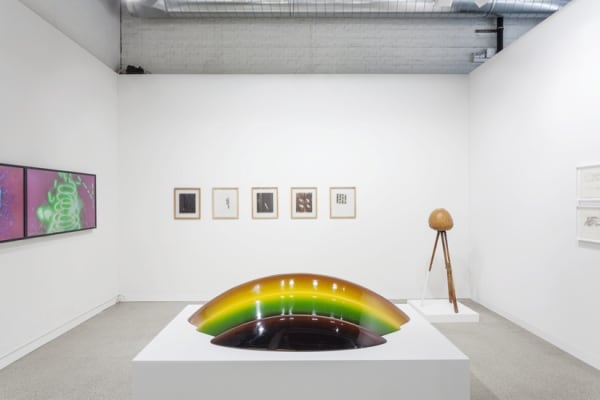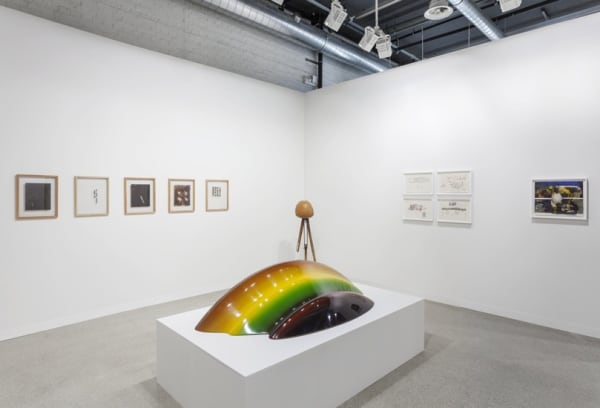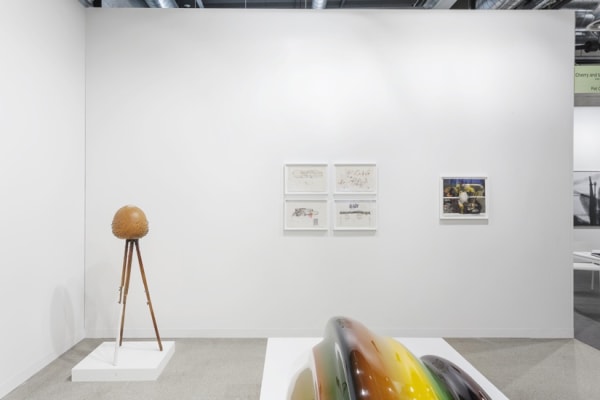(Cherry and Martin archive - Cherry and Martin is now Philip Martin Gallery.)
For the Feature section of Art Basel 2016, Cherry and Martin is proud to present a solo exhibition of the work of Pat O’Neill (b. 1939, Los Angeles).
Long recognized as a pioneer in avant-garde film, Pat O'Neill is probably the first American to receive an MA in moving image art. Cherry and Martin's presentation will include a new 3-channel edit of O’Neill’s landmark film "Saugus Series" (1974); the monumental fiberglass sculpture, "Large Sweep (1012 Pico Series)” (1968); and a selection of transparency works and collages, 1965 to the present.
A friend and peer of Robert Heinecken, Pat O'Neill was in close conversation with the Bay Area-based Bruce Conner, East Coast filmmakers like Paul Sharits and Hollis Frampton, and a diverse group of LA-based artists loosely experimenting with the interaction between photography, installation and film. The five decades of Pat O'Neill's work reveal his keen interest in expanded photographic practice and its applications for both film and sculpture. As Manohla Dargis of The New York Times notes, in the late 60s O'Neill, "introduced optical printing into his work, a step that allowed him to maximize the medium's plasticity several decades before computer-based composition systems made image manipulation widely accessible. In an optical printer, filmed images are copied onto raw film stock, allowing the filmmaker to subject the images to an array of photographic techniques, including fades and multiple exposures. Optical printers have various industrial uses, but one distinct advantage for film artists is that they allow them to manipulate live-action images the way animators do.”
"Saugus Series" takes on Los Angeles as an uncertain subject, a displaced location in space and time. Shot in and around the city and other locations in California with "the intent to produce "synthetic" depictions of locations made up of multiple and disparate parts," O'Neill combines the visual effects with a visceral soundtrack that demands the total attention of the viewer. As O'Neill writes, the goal is to "present an image that is both clearly understood and obviously altered. Altering the imagery from its original photographic state raises inevitable questions concerning its reception: What are we to believe? How is a representation changed by proximity with another? How does contradiction, itself, represent our experience?" He goes on to point out that, "My films share some of the concerns of
other experimental filmmakers worldwide: defining parameters for the representation of space and time, exploiting personal experience as metaphor, using archival materials in a restated context.”
In his 1970 book, "Expanded Cinema,” Gene Youngblood links O'Neill with Michael Snow and Stan Brakhage: ’synaesthetic’ filmmakers whose work explores cinema’s ‘extra-objective’ reality—in opposition to television—the new ‘software’ of the planet. For his part, O’Neill states, “The question seems to be one of finding a satisfactory container for one's observations.” Describing films like "Saugus Series," O’Neil goes on to point out that, “The individual parts were all made separately, so the film is not cohesive unless you can see it as a kind of journal, a collection of entries all by the same person but at different times and places. If you see it as a record of an individual who wanders the land and from time to time stops to comment on it, that is about right. The films move from one into the next, almost without interruption. All the time I was doing them, I was thinking about the form, thinking about a way to present film that was completely non-theatrical and non-sequential, that did not rely on any connection between its parts … the audience was free to come and go. I felt the need to get completely away from the theater situation as we know it.“
Pat O'Neill's work will be the subject of a solo exhibition at the Berkeley Art Museum/Pacific Film Archive in November 2016. O'Neill's work has been featured in such important exhibitions as Electric Art (1969, University of California, Los Angeles); 1991 Whitney Biennial (1991, Whitney Museum of American Art, New York); and Los Angeles 1955-1985: The Birth of an Art Capital (2005, Centre Pompidou). O'Neill's work was recently featured in Extracts and Extractions at Les Abbatoirs / Frac Midi-Pyrénés (Toulouse, France). Recent Museum acquisitions include San Francisco Museum of Art (San Francisco, CA); Berkeley Art Museum and Pacific Film Archive (Berkeley, CA); Hammer Museum (Los Angeles, CA); Los Angeles County Museum of Art (Los Angeles, CA); Nora Eccles Harrison Museum of Art (Ogden, UT); Walker Art Center (Minneapolis, MN); Carnegie Museum of Art (Pittsburgh, PA); Whitney Museum of American Art (New York, NY); and les Abbattoirs/FRAC Midi-Pyrénées (Toulouse, France). Pat O'Neill lives and works in Los Angeles.
Philip Martin Gallery hours are Tuesday through Saturday from 10am-6pm and by appointment. For further information and images please contact the gallery at +310-559-0100 or info@philipmartingallery.com.
Philip Martin Gallery
2712 S. La Cienega Blvd.
Los Angeles, CA 90034
+310-559-0100
info@philipmartingallery.com





